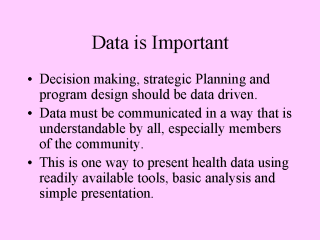| front |1 |2 |3 |4 |5 |6 |7 |8 |9 |10 |11 |12 |13 |14 |15 |16 |17 |18 |19 |20 |review |
 |
Decision-making,
strategic planning and program design should be data driven. Appropriate data is often
available, but the process of analysis is daunting for many. Even persons trained in
statistics often have trouble communicating data in a way that can be understood by all,
especially members of the community. Allegheny County Health Department (ACHD) has developed a method for analyzing and presenting data that uses readily available tools (Lotus or Excel), basic analysis, and simple presentation. Several years of data can be represented as a single number for comparison. Trends can be analyzed with this process and represent by a single number, or presented graphically. This was used successfully by ACHD for strategic planning. The data was used by staff and a large steering committee that represented universities, health care, and the community. Health professionals often look at disparities in health outcomes between racial, ethnic, indigenous or tribal groups. This method is an objective approach that does not rely on postulating the existence of disparities. However, it makes disparities obvious, and quantifies them. Data should help you understand reality. It should make you think about what’s happening. If you have one data point over a period that is wildly different from the others, you should always ask, what has happened at that time. You might also question the validity of the data point – maybe somebody copied the wrong number, etc. |
| front |1 |2 |3 |4 |5 |6 |7 |8 |9 |10 |11 |12 |13 |14 |15 |16 |17 |18 |19 |20 |review |